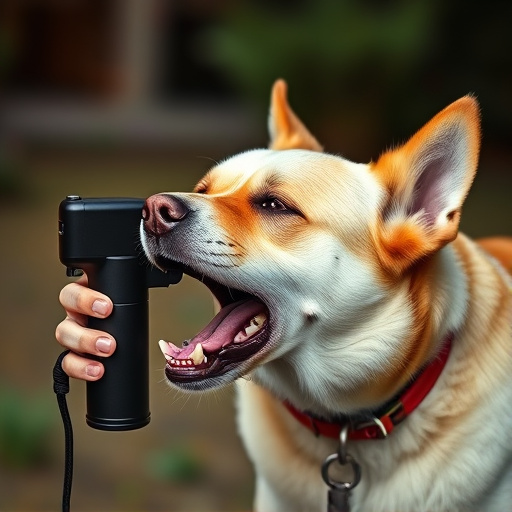Dog deterrent sprays use capsaicin or synthetic chemicals to discourage dogs from entering treated areas, offering quick protection in emergency situations involving masked animals. Their effectiveness requires regular reapplication, and legal frameworks govern their sale and use, with mail-approved options available for non-lethal control of aggressive canines. Safety measures include protective gear, ventilation, and keeping people and pets away until the spray dries. Accidental exposure necessitates immediate water rinsing and veterinary assistance if irritation occurs. Testing on small areas and adhering to manufacturer instructions and local regulations are crucial to ensure humane deterrence while providing emergency care for maced animals.
“Discover the power of dog deterrent sprays, a non-lethal solution for managing canine behavior. This comprehensive guide explores ‘Understanding Dog Deterrent Sprays’, delving into their mechanisms and effectiveness. We navigate ‘Legal Considerations’ to ensure compliance with mail-approved options available in today’s market. Learn essential ‘Safety Precautions’ for responsible application. Additionally, we provide critical insights on ‘Emergency Care for Exposed Animals’, equipping you with knowledge to promptly address potential issues.”
- Understanding Dog Deterrent Sprays: What They Are and How They Work
- Legal Considerations: Mail-Approved Dog Deterrent Spray Solutions
- Safety Precautions for Applying Dog Deterrent Sprays
- Emergency Care for Exposed Animals: When and How to Seek Help
Understanding Dog Deterrent Sprays: What They Are and How They Work
Dog deterrent sprays are specialized products designed to protect people and property from unwanted canine interactions. These sprays utilize a variety of ingredients, often including capsaicin, the active compound found in chili peppers, or synthetic chemicals that mimic natural deterrents. When applied, they create an unpleasant sensory experience for dogs, encouraging them to avoid certain areas. This is particularly useful in scenarios requiring emergency care for masked animals, where swift and effective deterrence can prevent potential harm to both humans and other pets.
The effectiveness of dog deterrent sprays lies in their ability to trigger a natural instinct to avoid the treated area. Dogs have sensitive olfactory systems, and the distinct odors left by these sprays can create a psychological barrier, teaching them to steer clear. Regular application is crucial for maintaining deterrence, as the spray’s potency can diminish over time, requiring reapplication to ensure continued protection.
Legal Considerations: Mail-Approved Dog Deterrent Spray Solutions
When considering dog deterrent spray as a solution, it’s crucial to understand the legal framework surrounding its use, especially when approved for mail delivery. Each country and region has specific regulations regarding the sale, possession, and application of such products to protect both public safety and animal welfare. For instance, in many places, dog deterrent sprays containing capsaicin or similar irritants are only legally accessible through prescription or as a last resort for emergency care of dangerously aggressive animals.
Mail-approved solutions often cater to this need by offering non-lethal alternatives that can be discreetly delivered and used by authorized individuals, such as animal control officers or property owners facing severe threats from uncontrolled canine behavior. These products must adhere to strict guidelines to ensure their safety and effectiveness while promoting humane methods of deterrence, thus avoiding the necessity for more invasive emergency care for maced animals.
Safety Precautions for Applying Dog Deterrent Sprays
When applying dog deterrent sprays, safety should be a top priority. Always wear protective clothing, including gloves and long sleeves, to minimize skin contact with the spray. Ensure proper ventilation by using the product outdoors or in a well-ventilated area. Keep pets and children away from the application zone for the duration of use and until the spray has fully dried. In case of accidental exposure, have emergency care for affected animals readily available, including a supply of water for rinsing and contact with a veterinarian if irritation occurs.
Remember that not all dogs will react in the same way to deterrent sprays; some may be more sensitive than others. Test the product on a small area first to observe any adverse reactions before full application. Follow the manufacturer’s instructions carefully, including recommended spray distances and duration of effect. Regularly check local regulations regarding the use of dog deterrents to ensure compliance with laws and guidelines aimed at protecting both pets and public safety.
Emergency Care for Exposed Animals: When and How to Seek Help
If your pet comes into contact with dog deterrent spray, it’s crucial to act swiftly in providing emergency care. The first step is to thoroughly rinse the affected area with water for at least 15 minutes, ensuring all traces of the spray are removed. This immediate action can prevent further irritation or potential harm caused by the chemicals.
In cases of severe reactions, such as difficulty breathing, excessive itching, redness, or swelling, it’s essential to seek veterinary assistance immediately. Emergency care for exposed animals may involve administering antihistamines, corticosteroids, or other medications to alleviate symptoms and reduce discomfort. It’s always best to consult a veterinarian who can provide guidance tailored to your pet’s specific situation.
Dog deterrent sprays can be a safe and effective solution for managing unwanted dog interactions, but responsible use and awareness of legal guidelines are paramount. When dealing with potential hazards, ensuring proper application techniques and having emergency care plans in place for exposed animals is crucial. By understanding the mechanics and legal considerations surrounding these sprays, pet owners and enthusiasts can contribute to a more harmonious coexistence between humans and canine companions while also providing prompt emergency care should any adverse events occur.
